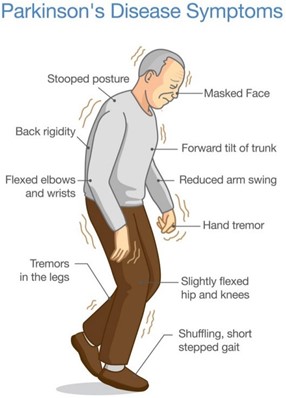A nurse is contributing to the plan of care for a client who has Parkinson's disease. Which of the following interventions should the nurse plan to include?
Restrict the client's fluid intake
Keep suction equipment at the client's bedside
Instruct the client to look down when ambulating
Position the client supine after eating
The Correct Answer is B
b. Keep suction equipment at the client's bedside.
The nurse should plan to include keeping suction equipment at the client's bedside as an intervention for a client with Parkinson's disease. Parkinson's disease can cause dysphagia (difficulty swallowing) and an increased risk of aspiration. Having suction equipment readily available allows for prompt intervention in case of choking or aspiration episodes, ensuring the client's safety.
Explanation for the other options:
a. Restrict the client's fluid intake: Restricting the client's fluid intake is not typically indicated in the care of a client with Parkinson's disease. Adequate hydration is important for overall health and well-being. However, specific fluid restrictions may be necessary in certain situations, such as if the client has coexisting conditions like heart failure or kidney disease, which should be assessed and determined by the healthcare provider.
c. Instruct the client to look down when ambulating: In Parkinson's disease, individuals often experience a forward-flexed posture and a shuffling gait. Instructing the client to look down when ambulating is not an appropriate intervention. Instead, the nurse should encourage the client to maintain an upright posture, take smaller steps, and focus on taking deliberate and controlled movements to promote stability and reduce the risk of falls.
d. Position the client supine after eating: Positioning the client supine after eating is not recommended for a client with Parkinson's disease. This position can increase the risk of aspiration, as it may promote reflux and regurgitation of stomach contents. Instead, the nurse should advise the client to maintain an upright position, such as sitting in a chair or using a recliner with appropriate head support, to aid digestion and reduce the risk of aspiration.

Nursing Test Bank
Naxlex Comprehensive Predictor Exams
Related Questions
Correct Answer is C
Explanation
c. The toddler can say four words.
Explanation:
The nurse should report to the provider that the toddler can say four words. At 18 months, a toddler typically has a vocabulary of about 6 to 20 words and is beginning to combine words into simple phrases. If the toddler is only able to say four words or has a delay in language development, it could be a cause for concern and warrant further evaluation.
The other options are age-appropriate developmental milestones for an 18-month-old toddler and do not require immediate reporting to the provider. The ability to remove socks, having a security blanket, and throwing a ball without falling are all examples of normal developmental skills for a toddler of this age.
Correct Answer is A
Explanation
The correct answer is a. Call EMS if a seizure lasts 5 minutes or more.
Explanation:
When providing home care instructions for a child with a seizure disorder, it is important to educate the parents about appropriate actions during a seizure. Calling emergency medical services (EMS) if a seizure lasts 5 minutes or more is crucial because it may indicate a condition called status epilepticus, which is a prolonged seizure or a series of seizures without full recovery of consciousness between them. Status epilepticus is a medical emergency that requires immediate medical intervention.
Option b, restraining the child at the onset of a seizure, is not recommended. Restraint can potentially cause harm to the child and increase the risk of injury. It is advised to create a safe environment by removing any nearby objects that could cause injury and placing a pillow or cushion under the child's head to prevent head injury.
Option c, offering the child a bubble bath every evening, is not specifically related to seizure management. Bathing routines can be continued as long as they are safe and supervised. However, it is important to ensure the child's safety during bathing, such as providing adequate supervision to prevent drowning or injury.
Option d, placing the child in a prone position during a seizure, is not recommended. Placing the child in a prone position (face down) during a seizure can obstruct the airway and increase the risk of respiratory complications. The child should be placed on their side, in a recovery position, to facilitate drainage of saliva or other fluids and prevent choking.
Overall, the most important instruction for the parents is to recognize the signs of prolonged seizure activity and to seek immediate medical assistance by calling EMS if a seizure lasts 5 minutes or more.
Whether you are a student looking to ace your exams or a practicing nurse seeking to enhance your expertise , our nursing education contents will empower you with the confidence and competence to make a difference in the lives of patients and become a respected leader in the healthcare field.
Visit Naxlex, invest in your future and unlock endless possibilities with our unparalleled nursing education contents today
Report Wrong Answer on the Current Question
Do you disagree with the answer? If yes, what is your expected answer? Explain.
Kindly be descriptive with the issue you are facing.
